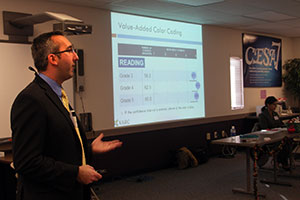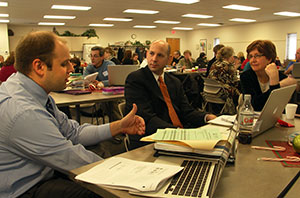Upping Value-Added Knowledge in Northeast Wisconsin
January 15, 2013

VARC production manager Sean McLaughlin
Sean McLaughlin is a rare breed. As a self-proclaimed data geek, that McLaughlin is comfortable interpreting a screen full of graphs, charts, and numbers does not come as a surprise. It’s when the bespectacled McLaughlin, standing in suit and tie in front of a large crowd of educators, begins to explain in fluid and easily digestible morsels just what the numbers mean that his true worth as a gifted instructor is revealed.
On Dec. 12, the Value-Added Research Center (VARC), where McLaughlin works as a production manager, sent him to Green Bay to host a morning seminar at the Cooperative Education Service Agency (CESA) #7, an association of school districts stretching from Sheboygan to Door County. His objective: explain how value-added research, which combines data taken from test scores with student demographics, can provide administrators insight into what teaching is working well in schools – and what lessons might be improved.
“We like to use the phrase, ‘Uncover, discover, and recover’ because that’s really what our goal is with value added – to get teachers to use the data to improve their teaching,” McLaughlin told the group.

Jacob Konrath and Seth Harvatine, both of the Sheboygan School District, and Marcia Flaherty, of the Manitowoc School District, discuss value added.
McLaughlin is intimately familiar with value-added research. Since 2007, VARC, a part of the Wisconsin Center for Education Research at the University of Wisconsin-Madison, has worked with Wisconsin’s Department of Public Instruction to craft the value-added model that is now used to analyze the academic growth of students across the state.
Using an analogy he created to illustrate how value added works, McLaughlin asked the administrators of CESA #7 to study the work of gardeners growing oak trees on separate sides of a valley. At first glance, the gardener who has grown the larger oak tree looks like he has been more effective at his task. But by the end of McLaughlin’s talk, the administrators of CESA #7 all came to the same conclusion: The different factors with which the two gardeners had to contend showed the second gardener had been more effective, even though his tree had not grown as tall overall.
At the end of the seminar, McLaughlin provided data on the schools in the districts of each attendee. In separate interviews, the administrators acknowledged the power of value added to give them a better idea of how their schools and teachers stack up.
“The data very much confirmed what I expected at our elementary school, especially in regard to our fourth grade math,” said Lori Neurohr, the elementary and middle school principal and district assessment coordinator in the Kohler School District. “Those value added scores are awesome and those teachers are doing an awesome job with our math. That confirmed what we thought and it’s nice to see. You can see clearly that this group of teachers is doing things that maybe some other teams are not. So I’m happy that I get to take that back and share (what I’ve learned).”
Candie Lehto, the assistant superintendent in the Oconto Falls School District, was equally enlightened by the value-added data for her schools. The data will give her teachers the ability to recognize that improvement in their work is possible, she said.
“You always know teaching has the biggest impact on student growth, but sometimes teachers make excuses for their students’ performance,” she said. “They shouldn’t -- and they can’t -- with value added. You get low scores on value added, and teachers have to face the fact that something is wrong. It’s not that they have low-achieving kids; it’s not their students’ low socioeconomic income; it’s straight up, you have to do something teacher-wise. As an administrator, that’s a nice piece of information to have.”
Value added will be a useful tool for improving education in Wisconsin, but effective instruction and training on the issue is vital to its successful implementation, said Kevin Steinhilber, the chief academic officer in the Appleton Area School District.
“I see value added fitting within the context of our school improvement process we’ve had in place … But the big challenge will be, how do you move your educators and the community in general to really come to understand it and appreciate it, rather than being skeptical because it’s using data in a new and different way? If we want it to succeed, we have to do well with educating the educators and families,” Steinhilber said.
McLaughlin said he and the rest of the experts at VARC acknowledge there’s a long way to go before value added is fully understood and appreciated by teachers and parents in Wisconsin and the rest of the country. But they’re ready for the challenge, he said. The VARC team has put in a countless number of painstaking hours staring at charts and linear regression lines to perfect its model, shaping it into the most comprehensive and accurate tool available to measure student growth across schools and districts in Wisconsin. The model, he added, is on its way to becoming a vital piece of the larger puzzle of education evaluation nationwide.
After so much hard work, it’s easy to talk about value added’s benefits, McLaughlin said. Even for a data geek.


